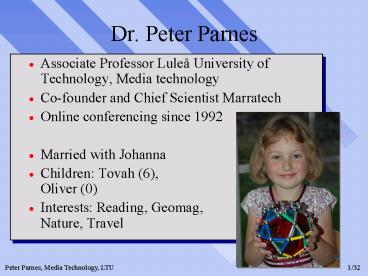Dr' Peter Parnes - PowerPoint PPT Presentation
1 / 32
Title:
Dr' Peter Parnes
Description:
Associate Professor Lule University of Technology, Media technology. Co-founder and Chief Scientist Marratech. Online conferencing since 1992. Married with Johanna ... – PowerPoint PPT presentation
Number of Views:30
Avg rating:3.0/5.0
Title: Dr' Peter Parnes
1
Dr. Peter Parnes
- Associate Professor Luleå University of
Technology, Media technology - Co-founder and Chief Scientist Marratech
- Online conferencing since 1992
- Married with Johanna
- Children Tovah (6), Oliver (0)
- Interests Reading, Geomag, Nature, Travel
2
Today
- Media Scaling
- Image and TV Compression
- Movie compression
- MPEG
- Image compression
- JPEG
3
- Media Scaling of
- IP-Multicast Streams in Heterogeneous Networks
- How to solve the many to many communication
problem?
4
- Which bandwidth should be used when transmitting
a real-time media stream over heterogeneous
networks?
5
Background
- Broadcasts of real-time media on the Internet
is becoming more and more important. - If the used system shall scale, IP-multicast HAS
to be used!
6
Requirements and Restrictions
- Best-effort delivery
- Reliability not required
- Applications have to be adaptive, i.e. have to
adapt to network congestion and be able to handle
different configurations.
7
Proposed solutions
- Max/Min client bandwidth
- Simulcast
- Network transcoders
- Receiver driven Layered Multicast - RLM
- Bandwidth Guessing - TCP friendly
- Active Networks
- Active Services
8
Max/Min client bandwidth
- Just ignore some set of receivers
- Send the stream with high bandwidth
- Ignore low bandwidth receivers
- Send the stream with low bandwidth
- Force high bandwidth receivers to use low quality
- Does not take congestion into account
9
Simulcast
- Send the same stream with different encodings
from the sender and let the receivers choose what
they want to receive. - Can be very expensive CPU wise
- Wastes bandwidth on shared links
- Does not take congestion into account in the way
it is being used today. - Used in mStar (more later)
10
Network Transcoders(Media Gateways)
- A common approach is to deploy transcoders on the
boundaries between different networks. - Transcoding
- Mixing
- Downscaling
11
Media Gateway
receivers
Transcoding gateways
GW
GW
Internet
GW
GW
R
GW
receivers
Video transmitter
12
Transcoding
- Transcoding
- transcode MJPEG to H.261 when the traffic leaves
a campus (high bandwidth network). -gt high CPU
requirement! - Used in SIRAM media gateway
13
Downscaling
- Downscaling
- Throw away parts of the media data
- Lower CPU than transcoding but worse result
- Used in mStar mTunnel
14
Mixing
- Mixing
- Generate one stream from several active streams.
- Mix audio
- Combine video
15
Receiver driven Layered Multicast - RLM
- Divide the stream into a hierarchy of exclusive
additive layers - Each layer is multicast to a different group
- loop
- if no_congestion then
- join next group to get higher layer
- else
- leave group to drop highest layer
16
RLM Problems
- How to detect congestion caused by my tests or by
others - Shared learning proposed
- Does it scale?
- Today long timeout in mcast forwarding trees
- Might lead to false interpretation of the current
situation - Is not nice to TCP
17
Layered Video
Low quality
GSM
Internet
Medium quality
Low quality
Modem
GRPS
R
Multicast Router
High-speed LAN
Sender
Video
High Quality
18
(No Transcript)
19
(No Transcript)
20
(No Transcript)
21
(No Transcript)
22
(No Transcript)
23
(No Transcript)
24
Bandwidth Guessing
- In early 97 a proposal called TCP-Friendly was
distributed. - Describes a way of estimating the bandwidth
between a sender and a receiver based on RTT and
current packet drop. - Takes TCP into account and will be a nice
participant in the network
25
BW Guessing Problems
- Hard to calculate RTT accurately
- Works only for broadcast situations
- Not very tested yet
26
Active Networks
- A buzzword in the network research area
- Basic idea
- Allow injection of small programs into network
nodes - Network nodes perform computations on user data
27
Active Networks...
- Two Different Approaches
- Code and control is handled out-of-band
- Each packet carries miniature programs (capsules)
- Allows networks to be modified on-demand
- Opens a completely new area for real-time media
scaling
28
Active Networks...
- Issues
- Safety, fairness, appropriate architecture,
common programming model, robustness - Status
- At the very beginning
- A very political problem
29
Active Services
- Deploy user controllable programs-pads in the
network. - Users can deploy their own transcoding programs
and can easily up-grade these when needed - A system for this is currently being deployed and
tested on Berkeley Campus
30
Status in Internet
- Almost all traffic is still sent using Unicast -
transcoding at the server - Network transcoders probably most common
- Simulcast less common than one could imagine
(lack of good support in todays applications).
31
Summary
- A number of more or less proposed solutions
- Max/Min client bandwidth
- Simulcast
- Network transcoders
- Receiver driven Layered Multicast - RLM
- Bandwidth Guessing - TCP friendly
- Active Networks
- Active Services
- Still a lot of research needed
32
- Questions?

